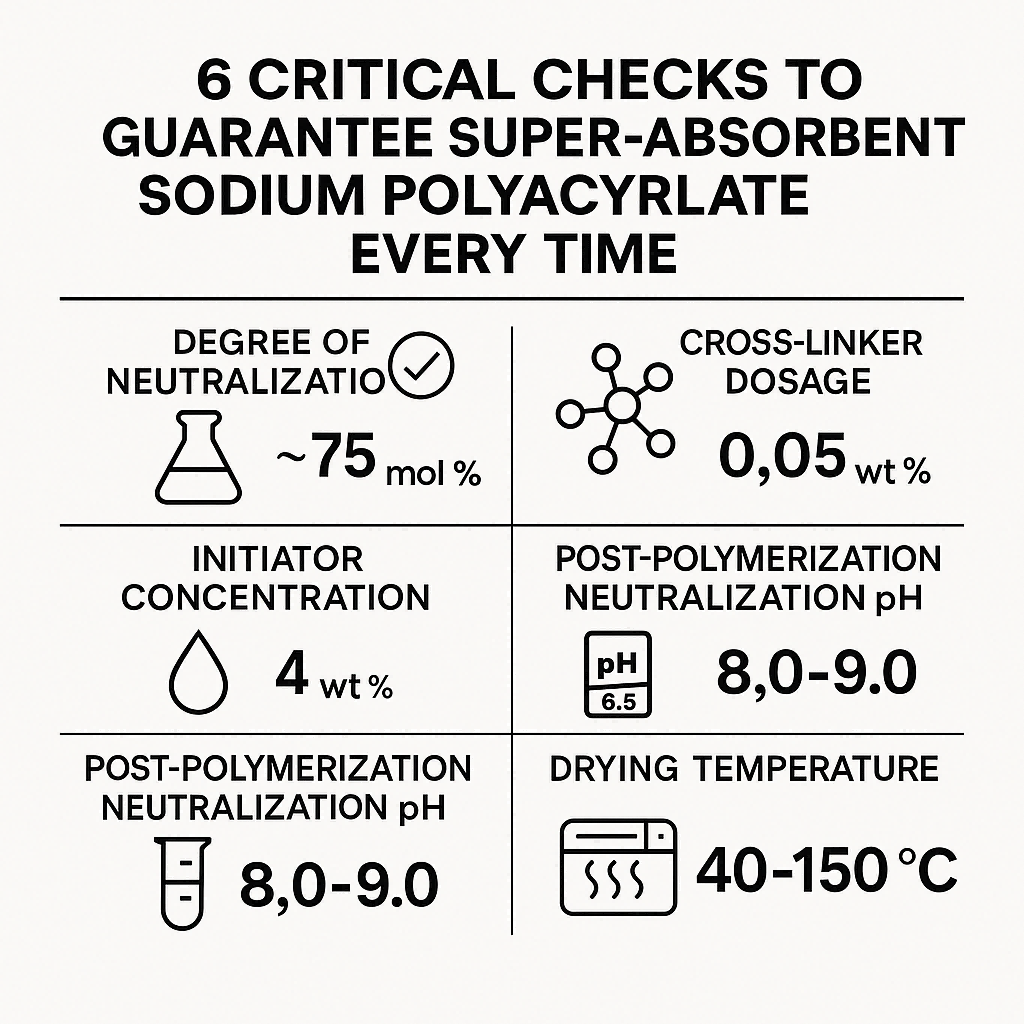6 Critical Checks to Guarantee Super-Absorbent Sodium Polyacrylate Every Time
In the world of hygiene products, agriculture, and industrial absorbents, consistency is king. A tiny deviation in your sodium polyacrylate (PAAS) recipe can mean lost absorbency, stickiness, or even production shutdowns. Here’s a quick guide to the six most vital quality-control parameters—and exactly why they matter.

1. Degree of Neutralization: ~75 mol %
After polymerization, acrylic acid units are partially converted to their sodium salts. Aim for 70–80 mol % neutralization—most factories settle around 75 mol % to balance gel strength and swelling capacity. Too low, and you lose absorbency; too high, and the polymer becomes overly viscous and harder to dry
2. Cross-Linker Dosage: 0.05 wt %
Cross-linkers like N,N′-methylene-bis-acrylamide (NMBA) lock polymer chains into a three-dimensional network. Industry benchmarks hover near 0.05 wt % relative to acrylic acid—enough to form a firm gel that still swells up to hundreds of times its weight
3. Initiator Concentration: 4 wt %
Free-radical initiators (e.g., ammonium persulfate) kick-start chain growth. A concentration around 4 wt % ensures rapid, uniform polymerization without excessive branching, which can weaken gel structure
4. Polymerization Temperature & Time: 60 °C for 1 h
Control the heat to manage reaction speed and molecular weight. 60 °C for 1 hour is a proven sweet spot—faster production, high-molecular-weight chains, and minimal unreacted monomer. Running hotter or longer risks discoloration or reduced absorbency
5. Post-Polymerization Neutralization pH: 8.0–9.0
Once the gel’s formed, fine-tune its sodium content by adjusting to pH 8.0–9.0 with a 30 wt % NaOH solution. This step not only completes neutralization but also pegs the viscosity—and ultimately, the dewatering and drying performance
6. Drying Temperature: 40–150 °C
Finally, remove residual moisture for shelf-stable beads. Drying between 40 °C and 150 °C yields a semi-solid that can be milled into fine particles. Below 40 °C is too slow; above 150 °C risks thermal degradation and color change
Why These Matter
-
Consistent Gel Strength: Cross-linker and neutralization directly impact mechanical toughness under load.
-
Reliable Absorbency: Optimal initiator levels and temperature profiles maximize swelling without sacrificing structure.
-
Smooth Production: Precise pH and drying controls prevent clogs, off-spec material, and keep your downstream drying and milling equipment humming.
By zeroing in on these six parameters, you’ll transform batch-to-batch variability into a bullet-proof, super-absorbent product—every single time.
References:
-
MDPI: BC/AA grafting using APS initiator (4 %) and NMBA cross-linker (0.05 %); 75 % AA neutralization; reaction at 60 °C for 1 h MDPI
-
US Patent US5856410: Post-polymerization neutralization and drying at 40 °C–150 °C 谷歌专利
-
ResearchGate: Influence of cross-linker type and amount on swelling characteristics researchgate.net

